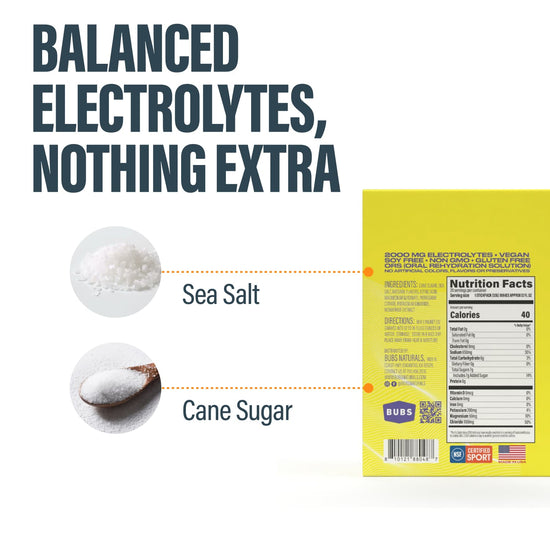Table of Contents
- Introduction
- What Are Electrolytes?
- Is Sodium an Electrolyte?
- The Importance of Sodium for Active Lifestyles
- Sodium Sources and Recommended Intake
- The Balance: Sodium and Other Electrolytes
- Health Implications of Sodium Imbalance
- Conclusion
- FAQ
Have you ever felt sluggish after a long workout or hike, only to realize you forgot to hydrate properly? Many of us often overlook the role that electrolytes, particularly sodium, play in our overall wellness. With our bodies being composed of approximately 60% water, electrolyte balance becomes crucial for our health and physical performance. Today, we're diving deep into the world of sodium, its role as an electrolyte, and why it matters for all of us, especially those leading active lifestyles.
Introduction
Sodium is often mentioned in health discussions, but its significance can be misunderstood. Did you know that sodium is not only a common seasoning but also a vital electrolyte that helps regulate essential bodily functions? In fact, sodium plays a pivotal role in maintaining fluid balance, supporting nerve function, and ensuring muscle contractions are executed correctly.
In this blog post, we’ll explore what sodium is, its classification as an electrolyte, and how it interacts with other minerals in the body. We aim to provide you with a comprehensive understanding of sodium’s importance, potential health implications of sodium imbalances, and practical advice for ensuring adequate electrolyte intake.
By the end of this post, you’ll have a clearer picture of how sodium functions within the body and the best practices to maintain a balanced electrolyte level. Whether you're an athlete, a weekend adventurer, or someone seeking to enhance overall wellness, this information is relevant to you.
What Are Electrolytes?
To grasp the significance of sodium, we first need to understand electrolytes. Electrolytes are minerals that carry an electrical charge when dissolved in water. This property allows them to conduct electricity, facilitating various bodily functions such as:
- Regulating Fluid Balance: Electrolytes help maintain the right amount of water in and around cells, ensuring optimal hydration.
- Supporting Nerve Function: They assist in transmitting electrical signals through the nervous system.
- Facilitating Muscle Contraction: Electrolytes are crucial for muscle function, enabling contractions and relaxation.
The primary electrolytes in the body include:
- Sodium (Na+)
- Potassium (K+)
- Calcium (Ca2+)
- Magnesium (Mg2+)
- Chloride (Cl-)
- Bicarbonate (HCO3-)
Among these, sodium is the most abundant positively charged electrolyte in the extracellular fluid, which surrounds cells.
Is Sodium an Electrolyte?
Yes, sodium is indeed classified as an electrolyte. As a mineral, it exists in our bodies primarily in its ionic form, which means it carries a positive electrical charge. Sodium plays several crucial roles, including:
- Fluid Balance: Sodium helps regulate blood volume and pressure by controlling water retention. When sodium levels fluctuate, so do fluid levels, which can lead to dehydration or swelling.
- Nerve Impulse Transmission: Sodium ions are essential for generating and conducting electrical impulses in nerve cells, allowing communication throughout the body.
- Muscle Contraction: Sodium works in tandem with potassium to facilitate muscle contractions. When a muscle is stimulated, sodium ions enter the muscle cells, leading to contraction.
Understanding sodium's role as an electrolyte emphasizes its significance in our daily wellness and performance, particularly for those of us engaged in physical activities.
The Importance of Sodium for Active Lifestyles
For those of us who lead active lifestyles, the significance of sodium cannot be overstated. Here’s why:
1. Hydration and Performance
During physical activities, we lose sodium through sweat. This loss can lead to dehydration, affecting performance and recovery. Proper hydration involves restoring electrolyte levels, particularly sodium, to maintain fluid balance.
To support optimal hydration, we recommend incorporating our Hydration products, which provide essential electrolytes without any added sugars, making them perfect for post-workout recovery.
2. Preventing Muscle Cramps
Muscle cramps can occur when sodium levels dip too low, especially during prolonged exercise. Ensuring adequate sodium intake can help prevent these painful contractions, allowing for seamless performance.
3. Supporting Blood Pressure Regulation
Sodium plays a vital role in regulating blood pressure. While excessive sodium can spike blood pressure, the right balance is necessary for cardiovascular health. It’s essential to monitor sodium intake—particularly from processed foods—while ensuring you consume enough during high-intensity activities.
Sodium Sources and Recommended Intake
Natural Sources of Sodium
Sodium is naturally found in various foods, including:
- Seafood: Fish and shellfish often contain higher sodium levels.
- Vegetables: Celery and beets are naturally rich in sodium.
- Dairy Products: Milk and cheese contain sodium, contributing to daily intake.
Processed Foods
Many processed foods are high in sodium, as it’s commonly used as a preservative and flavor enhancer. Examples include:
- Canned Soups and Vegetables
- Snack Foods: Chips and pretzels are often loaded with salt.
- Condiments: Soy sauce, ketchup, and dressings can have significant sodium content.
Daily Recommendations
The general recommendation for sodium intake is less than 2,300 mg per day for adults. However, athletes or individuals engaged in intense physical activities may require higher amounts to replenish losses through sweat.
The Balance: Sodium and Other Electrolytes
While sodium is essential, it’s crucial to maintain a balance with other electrolytes, such as potassium. An imbalance, particularly excessive sodium paired with insufficient potassium, can lead to health issues like high blood pressure and cardiovascular problems.
Sodium vs. Potassium
- Sodium: Predominantly found outside cells, it helps regulate fluid balance and blood pressure.
- Potassium: Mostly located inside cells, it aids in muscle contractions and nerve signaling.
A diet rich in fruits and vegetables, particularly potassium-rich foods like bananas, oranges, and spinach, can help maintain this balance.
Health Implications of Sodium Imbalance
Hyponatremia (Low Sodium Levels)
Hyponatremia occurs when sodium levels in the blood drop below normal, often due to excessive water intake or conditions that affect sodium retention. Symptoms may include:
- Nausea
- Headaches
- Confusion
- Fatigue
Hypernatremia (High Sodium Levels)
Hypernatremia, on the other hand, arises from dehydration or excessive sodium intake, leading to symptoms such as:
- Thirst
- Rapid heartbeat
- Restlessness
- Muscle spasms
Maintaining a proper sodium balance is essential for avoiding these conditions and promoting overall health.
Conclusion
In summary, sodium is a vital electrolyte that plays a crucial role in maintaining fluid balance, supporting nerve function, and facilitating muscle contractions. Understanding its importance, especially for those of us who lead active lifestyles, is essential for optimizing health and performance.
By being mindful of our sodium intake and balancing it with other electrolytes, we can enhance our hydration strategies and overall wellness. At BUBS Naturals, we believe in supporting your active lifestyle with clean, effective supplements. Explore our Hydration collection to discover how our products can help you replenish vital electrolytes and feel your best.
FAQ
1. What are electrolytes, and why are they important? Electrolytes are minerals that carry an electrical charge and are essential for various bodily functions, including fluid balance, nerve signaling, and muscle contraction.
2. How much sodium do I need daily? The general recommendation for adults is less than 2,300 mg per day. Athletes may need more to replenish losses from sweating.
3. What are some signs of sodium imbalance? Symptoms of low sodium (hyponatremia) include nausea and confusion, while high sodium (hypernatremia) can lead to thirst and muscle spasms.
4. Can I get enough sodium from my diet? Yes, sodium is present in many foods, both naturally and as an additive in processed products. However, it's essential to monitor intake to avoid excessive consumption.
5. How can I maintain a balance of electrolytes? Eating a varied diet rich in fruits, vegetables, and whole foods, combined with proper hydration, can help maintain electrolyte balance. Consider using supplements like our Hydration products to support your needs during physical activities.
Explore our Hydration collection today and feel the BUBS difference!
Written by:
Bubs Naturals

Hydrate or Die
When you’re sweating hard—whether it’s from a tough workout, a long day in the sun, or just life—your body needs more than water to stay balanced and energized.
Hydrate or Die® delivers 2,000 mg of electrolytes in every serving to help you rehydrate faster, fight off fatigue, and keep going strong. That includes the right mix of sodium, potassium, and magnesium to support muscle function, prevent cramps, and maintain energy levels.
With a small dose of natural cane sugar to speed up absorption, this clean, easy-to-use powder is made for real performance—not just flavor.
Starts at $29.60
Shop

